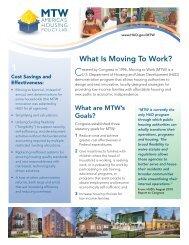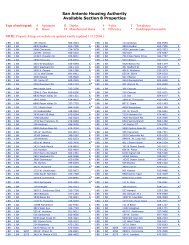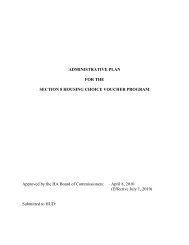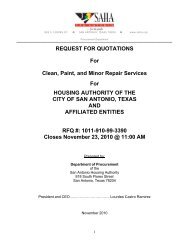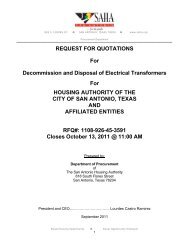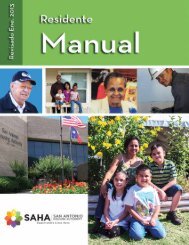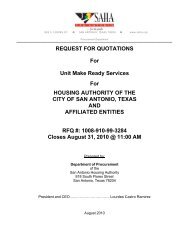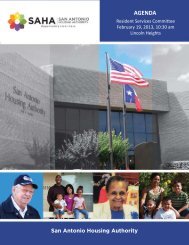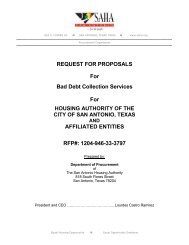Page 15-1 Chapter 15 SPECIAL HOUSING TYPES [24 CFR 982 ...
Page 15-1 Chapter 15 SPECIAL HOUSING TYPES [24 CFR 982 ...
Page 15-1 Chapter 15 SPECIAL HOUSING TYPES [24 CFR 982 ...
You also want an ePaper? Increase the reach of your titles
YUMPU automatically turns print PDFs into web optimized ePapers that Google loves.
<strong>15</strong>-III.A. OVERVIEWPART III: GROUP HOME[<strong>24</strong> <strong>CFR</strong> <strong>982</strong>.610 through <strong>982</strong>.614 and HCV GB p. 7-4]A group home is a state-licensed facility intended for occupancy by elderly persons and/orpersons with disabilities. Except for live-in aides, all persons living in a group home, whetherassisted or not, must be elderly persons or persons with disabilities. Persons living in a grouphome must not require continuous medical or nursing care.A group home consists of bedrooms for residents, which can be shared by no more than twopeople, and a living room, kitchen, dining area, bathroom, and other appropriate social,recreational, or community space that may be shared with other residents.No more than 12 persons may reside in a group home including assisted and unassisted residentsand any live-in aides.If approved by SAHA, a live-in aide may live in the group home with a person with disabilities.SAHA must approve a live-in aide if needed as a reasonable accommodation so that the programis readily accessible to and usable by persons with disabilities.When providing HCV assistance in a group home, a separate lease and HAP contract is executedfor each assisted family, and the standard form of the HAP contract is used.<strong>15</strong>-III.B. PAYMENT STANDARD, UTILITY ALLOWANCE, AND HAPCALCULATIONUnless there is a live-in aide, the family unit size for an assisted occupant of a group home mustbe 0- or 1-bedroom, depending on SAHA’s subsidy standard. If there is a live-in aide, the aidemust be counted in determining the household’s unit size.The payment standard used to calculate the HAP is the lower of the payment standard for thefamily unit size or the prorata share of the payment standard for the group home size. The proratashare is calculated by dividing the number of persons in the assisted household by the number ofpersons (assisted and unassisted) living in the group home.The HAP for an assisted occupant in a group home is the lower of the payment standard minusthe TTP or the gross rent minus the TTP.The utility allowance for an assisted occupant in a group home is the prorata share of the utilityallowance for the group home.The rents paid for participants residing in group homes are subject to generally applicablestandards for rent reasonableness. The rent for an assisted person must not exceed the prorataportion of the reasonable rent for the group home. In determining reasonable rent, SAHA shouldconsider whether sanitary facilities and facilities for food preparation and service are commonfacilities or private facilities.© Copyright 2006 Nan McKay & Associates, Inc. <strong>Page</strong> <strong>15</strong>-5Adminplan 12/1/06Unlimited copies may be made for internal use.
<strong>15</strong>-III.C. <strong>HOUSING</strong> QUALITY STANDARDSHQS requirements described in <strong>Chapter</strong> 8 apply to group homes except for the requirementsstated below.• Sanitary Facilities: A group home must have at least one bathroom in the facility, with aflush toilet that can be used in privacy, a fixed basin with hot and cold running water, and ashower or bathtub with hot and cold running water. A group home may contain private orcommon bathrooms. However, no more than four residents can be required to share abathroom.• Food Preparation and Service: Group home units must contain a kitchen and dining areawith adequate space to store, prepare, and serve food. The facilities for food preparation andservice may be private or may be shared by the residents. The kitchen must contain a range,an oven, a refrigerator, and a sink with hot and cold running water. The sink must drain intoan approvable public or private disposal system.• Space and Security: Group homes must contain at least one bedroom of appropriate size forevery two people, and a living room, kitchen, dining area, bathroom, and other appropriatesocial, recreational, or community space that may be shared with other residents.• Structure and Material: To avoid any threat to the health and safety of the residents, grouphomes must be structurally sound. Elevators must be in good condition. Group homes mustbe accessible to and usable by residents with disabilities.• Site and Neighborhood: Group homes must be located in a residential setting. The site andneighborhood should be reasonably free from hazards to the health, safety, and generalwelfare of the residents, and should not be subject to serious adverse conditions, such as:- Dangerous walks or steps- Instability- Flooding, poor drainage- Septic tank back-ups- Sewage hazards- Mud slides- Abnormal air pollution- Smoke or dust- Excessive noise- Vibrations or vehicular traffic- Excessive accumulations of trash- Vermin or rodent infestation, and- Fire hazards.The housing quality standards applicable to lead-based paint do not apply.© Copyright 2006 Nan McKay & Associates, Inc. <strong>Page</strong> <strong>15</strong>-6Adminplan 12/1/06Unlimited copies may be made for internal use.
<strong>15</strong>-IV.A. OVERVIEWPART IV: SHARED <strong>HOUSING</strong>[<strong>24</strong> <strong>CFR</strong> <strong>982</strong>.6<strong>15</strong> through <strong>982</strong>.618]Shared housing is a single housing unit occupied by an assisted family and another resident orresidents. The shared unit consists of both common space for use by the occupants of the unitand separate private space for each assisted family.An assisted family may share a unit with other persons assisted under the HCV program or withother unassisted persons. The owner of a shared housing unit may reside in the unit, but housingassistance may not be paid on behalf of the owner. The resident owner may not be related byblood or marriage to the assisted family.If approved by SAHA, a live-in aide may reside with the family to care for a person withdisabilities. SAHA must approve a live-in aide if needed as a reasonable accommodation so thatthe program is readily accessible to and usable by persons with disabilities.When providing HCV assistance in shared housing, a separate lease and HAP contract areexecuted for each assisted family, and the standard form of the HAP contract is used.<strong>15</strong>-IV.B. PAYMENT STANDARD, UTILITY ALLOWANCE AND HAP CALCULATIONThe payment standard for a family in shared housing is the lower of the payment standard for thefamily unit size or the prorata share of the payment standard for the shared housing unit size.The prorata share is calculated by dividing the number of bedrooms available for occupancy bythe assisted family in the private space by the total number of bedrooms in the unit.The HAP for a family in shared housing is the lower of the payment standard minus the TTP orthe gross rent minus the TTP. The utility allowance for an assisted family living in sharedhousing is the prorata share of the utility allowance for the shared housing unit.The rents paid for families living in shared housing are subject to generally applicable standardsfor rent reasonableness. The rent paid to the owner for the assisted family must not exceed thepro-rata portion of the reasonable rent for the shared unit. In determining reasonable rent, SAHAshould consider whether sanitary and food preparation areas are private or shared.<strong>15</strong>-IV.C. <strong>HOUSING</strong> QUALITY STANDARDSSAHA may not give approval to reside in shared housing unless the entire unit, including theportion of the unit available for use by the assisted family under its lease, meets the housingquality standards.HQS requirements described in <strong>Chapter</strong> 8 apply to shared housing except for the requirementsstated below.• Facilities Available for the Family: Facilities available to the assisted family, whether sharedor private, must include a living room, a bathroom, and food preparation and refuse disposalfacilities.© Copyright 2006 Nan McKay & Associates, Inc. <strong>Page</strong> <strong>15</strong>-7Adminplan 12/1/06Unlimited copies may be made for internal use.
• Space and Security: The entire unit must provide adequate space and security for all assistedand unassisted residents. The private space for each assisted family must contain at least onebedroom for each two persons in the family. The number of bedrooms in the private space ofan assisted family must not be less than the family unit size. A 0-bedroom or 1-bedroom unitmay not be used for shared housing.© Copyright 2006 Nan McKay & Associates, Inc. <strong>Page</strong> <strong>15</strong>-8Adminplan 12/1/06Unlimited copies may be made for internal use.
<strong>15</strong>-V.A. OVERVIEWPART V: COOPERATIVE <strong>HOUSING</strong>[<strong>24</strong> <strong>CFR</strong> <strong>982</strong>.619]This part applies to rental assistance for a cooperative member residing in cooperative housing. Itdoes not apply to assistance for a cooperative member who has purchased membership under theHCV homeownership option, or to rental assistance for a family that leases a cooperativehousing unit from a cooperative member.A cooperative is a form of ownership (nonprofit corporation or association) in which theresidents purchase memberships in the ownership entity. Rather than being charged “rent” acooperative member is charged a “carrying charge.”When providing HCV assistance in cooperative housing, the standard form of the HAP contractis used.<strong>15</strong>-V.B. PAYMENT STANDARD, UTILITY ALLOWANCE AND HAP CALCULATIONThe payment standard and utility allowance are determined according to regular HCV programrequirements.The HAP for a cooperative housing unit is the lower of the payment standard minus the TTP orthe monthly carrying charge for the unit, plus any utility allowance, minus the TTP. The monthlycarrying charge includes the member’s share of the cooperative debt service, operating expenses,and necessary payments to cooperative reserve funds. The carrying charge does not includedown payments or other payments to purchase the cooperative unit or to amortize a loan made tothe family for this purpose.<strong>15</strong>-V.C. <strong>HOUSING</strong> QUALITY STANDARDSAll standard HQS requirements apply to cooperative housing units. There are no additional HQSrequirements.© Copyright 2006 Nan McKay & Associates, Inc. <strong>Page</strong> <strong>15</strong>-9Adminplan 12/1/06Unlimited copies may be made for internal use.
<strong>15</strong>-VI.A. OVERVIEWPART VI: MANUFACTURED HOMES[<strong>24</strong> <strong>CFR</strong> <strong>982</strong>.620 through <strong>982</strong>.6<strong>24</strong>]A manufactured home is a manufactured structure, transportable in one or more parts, that isbuilt on a permanent chassis, and designed for use as a principal place of residence. HCVassistedfamilies may occupy manufactured homes in two different ways.(1) A family can choose to rent a manufactured home already installed on a space and SAHAmust permit it. In this instance program rules are the same as when a family rents any otherresidential housing, except that there are special HQS requirements as provided in <strong>15</strong>-VI.Dbelow.(2) HUD also permits an otherwise eligible family that owns a manufactured home to rent aspace for the manufactured home and receive HCV assistance with the rent for the space. SAHAmay, but is not required to, provide assistance for such families.<strong>15</strong>-VI.B. <strong>SPECIAL</strong> POLICIES FOR MANUFACTURED HOME OWNERS WHO LEASEA SPACEFamily IncomeIn determining the annual income of families leasing manufactured home spaces, the value of thefamily’s equity in the manufactured home in which the family resides is not counted as a familyasset.Lease and HAP ContractThere is a separate Tenancy Addendum (Form 52642-a) and separate HAP Contract (Form52642) for this special housing type.<strong>15</strong>-VI.C. PAYMENT STANDARD, UTILITY ALLOWANCE AND HAP CALCULATIONPayment StandardsThe FMR for a manufactured home space is generally 40 percent of the published FMR for a 2-bedroom unit or, where approved by HUD, the 40th percentile of the rental distribution ofmanufactured home spaces for the FMR area. SAHA may establish a payment standard formanufactured home spaces that is between 90-110 percent of the FMR for manufactured homespaces.Utility AllowanceSAHA must establish utility allowances for manufactured home space rental. For the first 12months of the initial lease term only, the allowance must include an amount for a utility hook-upcharge if the family actually incurred a hook-up charge because of a move. This allowance willnot be given to a family that leases in place. Utility allowances for manufactured home spacemust not include the costs of digging a well or installing a septic system.© Copyright 2006 Nan McKay & Associates, Inc. <strong>Page</strong> <strong>15</strong>-10Adminplan 12/1/06Unlimited copies may be made for internal use.
Space RentThe space rent is the sum of the rent to the owner for the manufactured home space, any chargesfor maintenance and management provided by the owner, and the utility allowance for tenantpaidutilities.Housing Assistance PaymentThe HAP for a manufactured home space under the housing choice voucher program is the lowerof the payment standard minus the TTP or the (gross) manufactured home space rent minus theTTP.Rent ReasonablenessInitially, and annually thereafter SAHA must determine that the rent for the manufactured homespace is reasonable based on rents for comparable manufactured home spaces. SAHA mustconsider the location and size of the space, and any services and maintenance to be provided bythe owner. By accepting the monthly HAP check, the owner certifies that the rent does notexceed rents charged by the owner for comparable unassisted spaces in the manufactured homepark or elsewhere.<strong>15</strong>-VI.D. <strong>HOUSING</strong> QUALITY STANDARDSUnder either type of occupancy described in <strong>15</strong>-VI.A above, the manufactured home must meetall HQS performance requirements and acceptability criteria discussed in <strong>Chapter</strong> 8 of this plan.In addition, the following requirement applies:Manufactured Home Tie-DownA manufactured home must be placed on the site in a stable manner, and must be free fromhazards such as sliding or wind damage. The home must be securely anchored by a tie-downdevice that distributes and transfers the loads imposed by the unit to appropriate ground anchorsto resist overturning and sliding.© Copyright 2006 Nan McKay & Associates, Inc. <strong>Page</strong> <strong>15</strong>-11Adminplan 12/1/06Unlimited copies may be made for internal use.
PART VII: HOMEOWNERSHIP[<strong>24</strong> <strong>CFR</strong> <strong>982</strong>.625 through <strong>982</strong>.643]<strong>15</strong>-VII.A. OVERVIEW [<strong>24</strong> <strong>CFR</strong> <strong>982</strong>.625]The homeownership option is used to assist a family residing in a home purchased and owned byone or more members of the family. A family assisted under this option may be newly admittedor an existing participant in the HCV program. SAHA must have the capacity to operate asuccessful HCV homeownership program as defined by the regulations.There are two forms of homeownership assistance SAHA may offer under this option: monthlyhomeownership assistance payments, or a single down payment assistance grant. SAHA maychoose to offer either or both forms of homeownership assistance, or choose not to offer either.SAHA must offer either form of homeownership assistance if needed as a reasonableaccommodation so that the program is readily accessible to and usable by persons withdisabilities. It is the sole responsibility of SAHA to determine whether it is reasonable toimplement a homeownership program as a reasonable accommodation. SAHA must determinewhat is reasonable based on the specific circumstances and individual needs of the person with adisability. SAHA may determine that it is not reasonable to offer homeownership assistance as areasonable accommodation in cases where SAHA has otherwise opted not to implement ahomeownership program.SAHA must approve a live-in aide if needed as a reasonable accommodation so that the programis readily accessible to and usable by persons with disabilities.SAHA PolicySAHA has instituted a minimum homeowner down payment requirement of at least threepercent of the purchase price, and requires that at least one percent of the purchase pricecome from the family’s personal resources.SAHA will offer the monthly homeownership assistance payments to qualified families.<strong>15</strong>-VII.B. FAMILY ELIGIBILITY [<strong>24</strong> <strong>CFR</strong> <strong>982</strong>.627]The family must meet all of the requirements listed below before the commencement ofhomeownership assistance. SAHA may also establish additional initial requirements as long asthey are described in SAHA’s administrative plan.• The family must have been admitted to the Housing Choice Voucher program and in goodstanding for at least one year.• The homeownership option will be included in all Briefing and Re-Housing classes as well asmedia and community announcements. Current Section 8 participants must be in compliancewith their lease and program requirements and must terminate their current lease arrangementin compliance with the lease.• The family must qualify as a first-time homeowner, or may be a cooperative member.• The family must meet the Federal minimum income requirement. The family must have agross annual income equal to the Federal minimum wage multiplied by 2000, based on the© Copyright 2006 Nan McKay & Associates, Inc. <strong>Page</strong> <strong>15</strong>-12Adminplan 12/1/06Unlimited copies may be made for internal use.
income of adult family members who will own the home. SAHA may establish a higherincome standard for families. However, a family that meets the federal minimum incomerequirement (but not SAHA's requirement) will be considered to meet the minimum incomerequirement if it can demonstrate that it has been pre-qualified or pre-approved for financingthat is sufficient to purchase an eligible unit.• Public assistance income may not be used for meeting the minimum income requirement,except for households in which the head or co-head is elderly or disabled and households thatinclude a disabled person other than head or co-head. (Public Assistance includes federalhousing assistance or the housing component of a welfare grant; TANF assistance; SSI that issubject to an income eligibility test; food stamps; general assistance or other assistanceprovided under a Federal, state or local program that provides assistance available to meetfamily living or housing expenses.)• For disabled families, the minimum income requirement is equal to the current SSI monthlypayment for an individual living alone, multiplied by 12.• For elderly or disabled families, welfare assistance payments for adult family members whowill own the home will be included in determining whether the family meets the minimumincome requirement. It will not be included for other families.• The family must satisfy the employment requirements by demonstrating that one or moreadult members of the family who will own the home at commencement of homeownershipassistance is currently employed on a full-time basis (the term 'full-time employment' meansnot less than an average of 30 hours per week); and has been continuously so employedduring the year before commencement of homeownership assistance for the family.• The employment requirement does not apply to elderly and disabled families. In addition, if afamily, other than an elderly or disabled family includes a person with disabilities, SAHAmust grant an exemption from the employment requirement if SAHA determines that it isneeded as a reasonable accommodation.• The family has not defaulted on a mortgage securing debt to purchase a home under thehomeownership option• Except for cooperative members who have acquired cooperative membership shares prior tocommencement of homeownership assistance, no family member has a present ownershipinterest in a residence at the commencement of homeownership assistance for the purchase ofany home.• Except for cooperative members who have acquired cooperative membership shares prior tothe commencement of homeownership assistance, the family has entered a contract of sale inaccordance with <strong>24</strong> <strong>CFR</strong> <strong>982</strong>.631(c).SAHA PolicyFor disabled and elderly families, there will be no additional minimum income requirement.The requirements of <strong>982</strong>.627(c)(3) will be applicable.Families will be considered “continuously employed” if the break in employment does notexceed four months.© Copyright 2006 Nan McKay & Associates, Inc. <strong>Page</strong> <strong>15</strong>-13Adminplan 12/1/06Unlimited copies may be made for internal use.
SAHA will count self-employment in a business when determining whether the family meetsthe employment requirement.SAHA will impose additional eligibility requirements. To be eligible to participate in thehomeownership option, families must meet the following criteria:The family is not within the initial one-year period of a HAP Contract.The family does not owe money to SAHA.The family has not committed any serious or repeated violations of a SAHA-assistedlease within the past year.<strong>15</strong>-VII.C. SELECTION OF FAMILIES [<strong>24</strong> <strong>CFR</strong> <strong>982</strong>.626]Unless otherwise provided (under the homeownership option), SAHA may limit homeownershipassistance to families or purposes defined by SAHA, and may prescribe additional requirementsfor commencement of homeownership assistance for a family. Any such limits or additionalrequirements must be described in SAHA’s administrative plan.If SAHA limits the number of families that may participate in the homeownership option, SAHAmust establish a system by which to select families to participate.SAHA PolicyFamilies who have been participating in SAHA’s Family Self-Sufficiency program for atleast six months, or have graduated from the FSS program, will be recruited for participationin the homeownership program. Elderly and disabled families will automatically be recruitedas well.All families must meet eligibility requirements as defined in Section <strong>15</strong>-VII.B. of this plan.<strong>15</strong>-VII.D. ELIGIBLE UNITS [<strong>24</strong> <strong>CFR</strong> <strong>982</strong>.628]In order for a unit to be eligible, SAHA must determine that the unit satisfies all of the followingrequirements:• The unit must meet HUD’s “eligible housing” requirements. The unit may not be any of thefollowing:- A public housing or Indian housing unit;- A unit receiving Section 8 project-based assistance;- A nursing home, board and care home, or facility providing continual psychiatric,medical or nursing services;- A college or other school dormitory;- On the grounds of penal, reformatory, medical, mental, or similar public or privateinstitutions.• The unit must be under construction or already exist at the time the family enters into thecontract of sale.© Copyright 2006 Nan McKay & Associates, Inc. <strong>Page</strong> <strong>15</strong>-14Adminplan 12/1/06Unlimited copies may be made for internal use.
• The unit must be a one-unit property or a single dwelling unit in a cooperative orcondominium.• The unit must have been inspected by SAHA and by an independent inspector designated bythe family.• The unit must meet Housing Quality Standards (see <strong>Chapter</strong> 8).• For a unit where the family will not own fee title to the real property (such as a manufacturedhome), the home must have a permanent foundation and the family must have the right tooccupy the site for at least 40 years.• For SAHA-owned units all of the following conditions must be satisfied:- SAHA informs the family, both orally and in writing, that the family has the right topurchase any eligible unit and a SAHA-owned unit is freely selected by the familywithout pressure or steering from SAHA;- The unit is not ineligible housing;- SAHA obtains the services of an independent agency to inspect the unit for compliancewith HQS, review the independent inspection report, review the contract of sale,determine the reasonableness of the sales price and any SAHA provided financing. All ofthese actions must be completed in accordance with program requirements.SAHA must not approve the unit if SAHA has been informed that the seller is debarred,suspended, or subject to a limited denial of participation.<strong>15</strong>-VII.E. ADDITIONAL SAHA REQUIREMENTS FOR SEARCH AND PURCHASE [<strong>24</strong><strong>CFR</strong> <strong>982</strong>.629]It is the family’s responsibility to find a home that meets the criteria for voucher homeownershipassistance. SAHA may establish the maximum time that will be allowed for a family to locateand purchase a home, and may require the family to report on their progress in finding andpurchasing a home. If the family is unable to purchase a home within the maximum timeestablished by SAHA, SAHA may issue the family a voucher to lease a unit or place the family’sname on the waiting list for a voucher.SAHA PolicyThe family will be allowed 120 days to identify a unit and submit a sales contract to SAHAfor review. The family will be allowed an additional 120 days to close on the home. SAHAmay grant extensions to either of these periods for good cause. The length of theextension(s) will be determined on a case-by-case basis. Any request for an extension will bereviewed on a case-by-case basis. During these periods, the family will continue to receiveHCV rental assistance in accordance with any applicable lease and HAP contract until thefamily vacates the rental unit for its purchased home.All requests for extensions must be submitted in writing to SAHA prior to the expiration ofthe period for which the extension is being requested. SAHA will approve or disapprove theextension request within 10 business days. The family will be notified of SAHA’s decisionin writing.© Copyright 2006 Nan McKay & Associates, Inc. <strong>Page</strong> <strong>15</strong>-<strong>15</strong>Adminplan 12/1/06Unlimited copies may be made for internal use.
The family will be required to report their progress on locating and purchasing a home toSAHA every 30 days until the home is purchased.If the family cannot complete the purchase of a unit within the maximum required timeframe, and is not receiving rental assistance under a HAP contract at the time the search andpurchase time period expires, the family will be issued a voucher to lease a unit.<strong>15</strong>-VII.F. HOMEOWNERSHIP COUNSELING [<strong>24</strong> <strong>CFR</strong> <strong>982</strong>.630]Before commencement of homeownership assistance for a family, the family must attend andsatisfactorily complete the pre-assistance homeownership and housing counseling programrequired by SAHA. HUD suggests the following topics for the SAHA-required pre-assistancecounseling:• Home maintenance (including care of the grounds);• Budgeting and money management;• Credit counseling;• How to negotiate the purchase price of a home;• How to obtain homeownership financing and loan pre-approvals, including a description oftypes of financing that may be available, and the pros and cons of different types offinancing;• How to find a home, including information about homeownership opportunities, schools, andtransportation in SAHA jurisdiction;• Advantages of purchasing a home in an area that does not have a high concentration of lowincomefamilies and how to locate homes in such areas;• Information on fair housing, including fair housing lending and local fair housingenforcement agencies; and• Information about the Real Estate Settlement Procedures Act (12 U.S.C. 2601 et seq.)(RESPA), state and Federal truth-in-lending laws, and how to identify and avoid loans withoppressive terms and conditions.SAHA may adapt the subjects covered in pre-assistance counseling (as listed) to localcircumstances and the needs of individual families.SAHA may also offer additional counseling after commencement of homeownership assistance(ongoing counseling). If SAHA offers a program of ongoing counseling for participants in thehomeownership option, SAHA shall have discretion to determine whether the family is requiredto participate in the ongoing counseling.If SAHA does not use a HUD-approved housing counseling agency to provide the counseling,SAHA should ensure that its counseling program is consistent with the counseling providedunder HUD’s Housing Counseling program.SAHA PolicyFamilies must attend a pre-purchase counseling course prior to purchase and a post-purchasecourse after closing.© Copyright 2006 Nan McKay & Associates, Inc. <strong>Page</strong> <strong>15</strong>-16Adminplan 12/1/06Unlimited copies may be made for internal use.
<strong>15</strong>-VII.G. HOME INSPECTIONS, CONTRACT OF SALE, AND SAHA DISAPPROVALOF SELLER [<strong>24</strong> <strong>CFR</strong> <strong>982</strong>.631]Home InspectionsSAHA may not commence monthly homeownership assistance payments or provide downpayment assistance grants for a family until SAHA has inspected the unit and has determinedthat the unit passes HQS.An independent professional inspector selected by and paid for by the family must also inspectthe unit. The independent inspection must cover major building systems and components,including foundation and structure, housing interior and exterior, and the roofing, plumbing,electrical, and heating systems. The independent inspector must be qualified to report onproperty conditions, including major building systems and components.SAHA may not require the family to use an independent inspector selected by SAHA. Theindependent inspector may not be a SAHA employee or contractor, or other person under controlof SAHA. However, SAHA may establish standards for qualification of inspectors selected byfamilies under the homeownership option.SAHA may disapprove a unit for assistance based on information in the independent inspector’sreport, even if the unit was found to comply with HQS.When the family locates a home they wish to purchase and submits a copy of their purchaseoffer/contract, SAHA will conduct a Housing Quality Standards (HQS) inspection within areasonable period. Any items found not to meet HQS must be repaired before the unit can bedetermined eligible for the homeownership program.The family must hire an independent professional inspector, whose report must be submittedto SAHA for review. The inspector must be recognized by the Texas Real EstateCommission and may not be a SAHA employee.SAHA will review the professional report in a timely fashion and, based on the presence ofmajor physical problems, may disapprove the purchase of the home.If SAHA disapproves the purchase of a home, the family will be notified in writing of thereasons for the disapproval.SAHA will not conduct HQS inspections while the family is receiving homeownershipassistance.Contract of SaleBefore commencement of monthly homeownership assistance payments or receipt of a downpayment assistance grant, a member or members of the family must enter into a contract of salewith the seller of the unit to be acquired by the family. The family must give SAHA a copy ofthe contract of sale. The contract of sale must:• Specify the price and other terms of sale by the seller to the purchaser;• Provide that the purchaser will arrange for a pre-purchase inspection of the dwelling unit byan independent inspector selected by the purchaser;© Copyright 2006 Nan McKay & Associates, Inc. <strong>Page</strong> <strong>15</strong>-17Adminplan 12/1/06Unlimited copies may be made for internal use.
• Provide that the purchaser is not obligated to purchase the unit unless the inspection issatisfactory to the purchaser;• Provide that the purchaser is not obligated to pay for any necessary repairs; and• Contain a certification from the seller that the seller has not been debarred, suspended, orsubject to a limited denial of participation under <strong>CFR</strong> part <strong>24</strong>.Disapproval of a SellerIn its administrative discretion, SAHA may deny approval of a seller for the same reasons SAHAmay disapprove an owner under the regular HCV program [see <strong>24</strong> <strong>CFR</strong> <strong>982</strong>.306(c)].<strong>15</strong>-VII.H. FINANCING [<strong>24</strong> <strong>CFR</strong> <strong>982</strong>.632]SAHA may establish requirements for financing purchase of a home under the homeownershipoption. This may include requirements concerning qualification of lenders, terms of financing,restrictions concerning debt secured by the home, lender qualifications, loan terms, andaffordability of the debt. SAHA must establish policies describing these requirements in theadministrative plan.SAHA may not require that families acquire financing from one or more specified lenders,thereby restricting the family’s ability to secure favorable financing terms.SAHA PolicyAs a check against predatory lending, SAHA will review the financing of each purchasetransaction, including estimated closing costs. SAHA will review the loans for features, suchas balloon payments, adjustable rate mortgages, and unusually high interest rates, all ofwhich are prohibited. SAHA also will not approve “seller financing” or “owner-held”mortgages. Beyond these basic criteria, SAHA will rely on the lenders to determine that theloan will be affordable to program participants.The mortgage the family applies for must require a minimum down payment of at least 3% ofthe sales price with 1% of the down payment coming from the purchaser’s personal funds.SAHA will not require that the family have any more than the minimum of 1% of their ownmoney in the transaction. However, in cases where a lender is requiring a larger amount, thefamily may be held to the underwriting guidelines set by their lending institution.There is no prohibition against using local or State Community Development Block Grant(CDBG) or other subsidized financing in conjunction with the homeownership program.SAHA will approve a family’s request to utilize its Family Self-Sufficiency escrow accountfor down payment and/or closing costs when purchasing a unit under the HCVhomeownership option.<strong>15</strong>-VII.I. CONTINUED ASSISTANCE REQUIREMENTS; FAMILY OBLIGATIONS [<strong>24</strong><strong>CFR</strong> <strong>982</strong>.633]Homeownership assistance may only be paid while the family is residing in the home. If thefamily moves out of the home, SAHA may not continue homeownership assistance after the© Copyright 2006 Nan McKay & Associates, Inc. <strong>Page</strong> <strong>15</strong>-18Adminplan 12/1/06Unlimited copies may be made for internal use.
month when the family moves out. The family or lender is not required to refund to SAHA thehomeownership assistance for the month when the family moves out.Before commencement of homeownership assistance, the family must execute a statement inwhich the family agrees to comply with all family obligations under the homeownership option.The family must comply with the following obligations:• The family must comply with the terms of the mortgage securing debt incurred to purchasethe home, or any refinancing of such debt.• The family may not convey or transfer ownership of the home, except for purposes offinancing, refinancing, or pending settlement of the estate of a deceased family member. Useand occupancy of the home are subject to <strong>24</strong> <strong>CFR</strong> <strong>982</strong>.551 (h) and (i).• A home equity loan may not be acquired without the prior written consent of SAHA.• The family must supply information to SAHA or HUD as specified in <strong>24</strong> <strong>CFR</strong> <strong>982</strong>.551(b).The family must further supply any information required by SAHA or HUD concerningmortgage financing or refinancing, sale or transfer of any interest in the home, orhomeownership expenses.• The family must notify SAHA before moving out of the home.• The family must notify SAHA if the family defaults on the mortgage used to purchase thehome.• The family must, at annual re-certification, document that he or she is current on mortgage,insurance, and utility payments.• No family member may have any ownership interest in any other residential property.• The family must comply with the obligations of a participant family described in <strong>24</strong> <strong>CFR</strong><strong>982</strong>.551, except for the following provisions which do not apply to assistance under thehomeownership option: <strong>24</strong> <strong>CFR</strong> <strong>982</strong>.551(c), (d), (e), (f), (g) and (j).<strong>15</strong>-VII.J. MAXIMUM TERM OF HOMEOWNER ASSISTANCE [<strong>24</strong> <strong>CFR</strong> <strong>982</strong>.634]Except in the case of a family that qualifies as an elderly or disabled family, other familymembers (described below) shall not receive homeownership assistance for more than:• Fifteen years, if the initial mortgage incurred to finance purchase of the home has a term of20 years or longer; or• Ten years, in all other cases.The maximum term described above applies to any member of the family who:• Has an ownership interest in the unit during the time that homeownership payments aremade; or• Is the spouse of any member of the household who has an ownership interest in the unitduring the time homeownership payments are made.In the case of an elderly family, the exception only applies if the family qualifies as an elderlyfamily at the start of homeownership assistance. In the case of a disabled family, the exception© Copyright 2006 Nan McKay & Associates, Inc. <strong>Page</strong> <strong>15</strong>-19Adminplan 12/1/06Unlimited copies may be made for internal use.
applies if at any time during receipt of homeownership assistance the family qualifies as adisabled family.If, during the course of homeownership assistance, the family ceases to qualify as a disabled orelderly family, the maximum term becomes applicable from the date homeownership assistancecommenced. However, such a family must be provided at least 6 months of homeownershipassistance after the maximum term becomes applicable (provided the family is otherwise eligibleto receive homeownership assistance).If the family has received such assistance for different homes, or from different PHAs, the totalof such assistance terms is subject to the maximum term described in this part.<strong>15</strong>-VII.K. HOMEOWNERSHIP ASSISTANCE PAYMENTS AND HOMEOWNERSHIPEXPENSES [<strong>24</strong> <strong>CFR</strong> <strong>982</strong>.635]The monthly homeownership assistance payment is the lower of: the voucher payment standardminus the total tenant payment, or the monthly homeownership expenses minus the total tenantpayment.In determining the amount of the homeownership assistance payment, SAHA will use the samepayment standard schedule, payment standard amounts, and subsidy standards as those describedin elsewhere in this plan for the Housing Choice Voucher program.The payment standard will be the greater of the payment standard at commencement ofhomeownership assistance or payment standard at the most recent reexamination sincecommencement of homeownership assistance.SAHA may pay the homeownership assistance payments directly to the family, or at SAHA’sdiscretion, to a lender on behalf of the family. If the assistance payment exceeds the amount dueto the lender, SAHA must pay the excess directly to the family.Homeownership assistance for a family terminates automatically 180 calendar days after the lasthomeownership assistance payment on behalf of the family. However, SAHA may grant relieffrom this requirement in those cases where automatic termination would result in extremehardship for the family.SAHA must adopt policies for determining the amount of homeownership expenses to beallowed by SAHA in accordance with HUD requirements.Homeownership expenses (not including cooperatives) only include amounts allowed by SAHAto cover:• Principal and interest on initial mortgage debt, any refinancing of such debt, and anymortgage insurance premium incurred to finance purchase of the home;• Real estate taxes and public assessments on the home;• Home insurance;• SAHA allowance for maintenance expenses;• SAHA allowance for costs of major repairs and replacements;• SAHA utility allowance for the home;© Copyright 2006 Nan McKay & Associates, Inc. <strong>Page</strong> <strong>15</strong>-20Adminplan 12/1/06Unlimited copies may be made for internal use.
• Principal and interest on mortgage debt incurred to finance costs for major repairs,replacements or improvements for the home. If a member of the family is a person withdisabilities, such debt may include debt incurred by the family to finance costs needed tomake the home accessible for such person, if SAHA determines that allowance of such costsas homeownership expenses is needed as a reasonable accommodation so that thehomeownership option is readily accessible to and usable by such person;• Land lease payments where a family does not own fee title to the real property on which thehome is located; [see <strong>24</strong> <strong>CFR</strong> <strong>982</strong>.628(b)].• For a condominium unit, condominium operating charges or maintenance fees assessed bythe condominium homeowner association.Homeownership expenses for a cooperative member may only include amounts allowed bySAHA to cover:• The cooperative charge under the cooperative occupancy agreement including payment forreal estate taxes and public assessments on the home;• Principal and interest on initial debt incurred to finance purchase of cooperative membershipshares and any refinancing of such debt;• Home insurance;• SAHA allowance for maintenance expenses;• SAHA allowance for costs of major repairs and replacements;• SAHA utility allowance for the home; and• Principal and interest on debt incurred to finance major repairs, replacements orimprovements for the home. If a member of the family is a person with disabilities, such debtmay include debt incurred by the family to finance costs needed to make the home accessiblefor such person, if SAHA determines that allowance of such costs as homeownershipexpenses is needed as a reasonable accommodation so that the homeownership option isreadily accessible to and usable by such person.• Cooperative operating charges or maintenance fees assessed by the cooperative homeownerassociation.SAHA PolicySAHA’s housing assistance payment will be paid directly to the lender unless the mortgagecompany refuses to accept payments from more than one source. In such case, SAHA’shousing assistance payment will be paid directly to the family. If the assistance paymentexceeds the amount due to the lender, SAHA must pay the excess directly to the family.SAHA will allow the following homeownership expenses:Monthly homeownership payment. This includes principal and interest on initial mortgagedebt, taxes and insurance, and any mortgage insurance premium, if applicable.Utility Allowance. SAHA’s utility allowance for the unit, based on the current HCV utilityallowance schedule.© Copyright 2006 Nan McKay & Associates, Inc. <strong>Page</strong> <strong>15</strong>-21Adminplan 12/1/06Unlimited copies may be made for internal use.
Monthly maintenance allowance. The monthly maintenance allowance will be the annualmaintenance allowance, divided by twelve. The annual maintenance allowance will be set ata flat rate, currently $75.Monthly major repair/replacement allowance. The monthly major repair/replacementallowance will be the annual major repair/replacement allowance divided by twelve. Theannual major repair/replacement allowance will be set at a flat rate, currently $<strong>15</strong>0.Monthly co-op/condominium assessments. If applicable, the monthly amount of co-op orcondominium association operation and maintenance assessments.Monthly principal and interest on debt for improvements. Principal and interest formajor home repair, replacements, or improvements, if applicable.<strong>15</strong>-VII.L. PORTABILITY [<strong>24</strong> <strong>CFR</strong> <strong>982</strong>.636, <strong>982</strong>.637, <strong>982</strong>.353(b) and (c), <strong>982</strong>.552, <strong>982</strong>.553]Subject to the restrictions on portability included in HUD regulations and SAHA policies, afamily may exercise portability if the receiving PHA is administering a voucher homeownershipprogram and accepting new homeownership families. The receiving PHA may absorb the familyinto its voucher program, or bill the initial PHA.The family must attend the briefing and counseling sessions required by the receiving PHA. Thereceiving PHA will determine whether the financing for, and the physical condition of the unit,are acceptable. The receiving PHA must promptly notify the initial PHA if the family haspurchased an eligible unit under the program, or if the family is unable to purchase a homewithin the maximum time established by the PHA.<strong>15</strong>-VII.M. MOVING WITH CONTINUED ASSISTANCE [<strong>24</strong> <strong>CFR</strong> <strong>982</strong>.637]A family receiving homeownership assistance may move with continued tenant-based assistance.The family may move with voucher rental assistance or with voucher homeownership assistance.Continued tenant-based assistance for a new unit cannot begin so long as any family memberholds title to the prior home.SAHA may deny permission to move to a new unit with continued voucher assistance asfollows:• Lack of funding to provide continued assistance.• At any time, SAHA may deny permission to move with continued rental or homeownershipassistance in accordance with <strong>24</strong> <strong>CFR</strong> <strong>982</strong>.638, regarding denial or termination of assistance.• In accordance with SAHA’s policy regarding number of moves within a 12-month period.SAHA must deny the family permission to move to a new unit with continued voucher rentalassistance if:• The family defaulted on an FHA-insured mortgage; and• The family fails to demonstrate that the family has conveyed, or will convey, title to thehome, as required by HUD, to HUD or HUD's designee; and the family has moved, or willmove, from the home within the period established or approved by HUD.© Copyright 2006 Nan McKay & Associates, Inc. <strong>Page</strong> <strong>15</strong>-22Adminplan 12/1/06Unlimited copies may be made for internal use.
SAHA PolicyFor families participating in the homeownership option, requests to move will be approved ordenied in accordance with PHA policies in <strong>Chapter</strong> 10.SAHA will not require additional counseling of any families who move with continuedassistance.<strong>15</strong>-VII.N. DENIAL OR TERMINATION OF ASSISTANCE [<strong>24</strong> <strong>CFR</strong> <strong>982</strong>.638]At any time, SAHA may deny or terminate homeownership assistance in accordance with HCVprogram requirements in <strong>24</strong> <strong>CFR</strong> <strong>982</strong>.552 (Grounds for denial or termination of assistance) or <strong>24</strong><strong>CFR</strong> <strong>982</strong>.553 (Crime by family members).SAHA may also deny or terminate assistance for violation of participant obligations described in<strong>24</strong> <strong>CFR</strong> Parts <strong>982</strong>.551 or <strong>982</strong>.633 and in accordance with its own policy.SAHA must terminate voucher homeownership assistance for any member of family receivinghomeownership assistance that is dispossessed from the home pursuant to a judgment or order offoreclosure on any mortgage (whether FHA insured or non-FHA) securing debt incurred topurchase the home, or any refinancing of such debt.SAHA PolicyTermination of assistance for families participating in the homeownership option will bedone in accordance with the policies in <strong>Chapter</strong> 12.<strong>15</strong>-VII.O. MORTGAGE DEFAULT [<strong>24</strong> <strong>CFR</strong> <strong>982</strong>.638(d)SAHA must terminate voucher homeownership assistance for any member of family receivinghomeownership assistance that is dispossessed from the home pursuant to a judgment or order offoreclosure on any mortgage (whether FHA-insured or non-FHA) securing debt incurred topurchase the home, or any refinancing of such debt. SAHA, in its discretion, may permit thefamily to move to a new unit with continued voucher rental assistance. However, SAHA mustdeny such permission, if:(1) The family defaulted on an FHA-insured mortgage; and(2) The family fails to demonstrate that:(i) The family has conveyed, or will convey, title to the home, as required by HUD, toHUD or HUD's designee; and(ii) The family has moved, or will move, from the home within the period established orapproved by HUD.SAHA PolicyIf the family defaults on the home mortgage loan, the participant will not be able to use theHomeownership Voucher for rental housing but may reapply for the Section 8 waiting list.© Copyright 2006 Nan McKay & Associates, Inc. <strong>Page</strong> <strong>15</strong>-23Adminplan 12/1/06Unlimited copies may be made for internal use.



